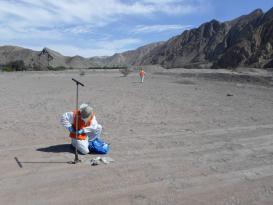The project "Baselining Pollution: Producing 'Natural Soil' for Environmental Regulation in Chile" examines the practical construction and usage of baselines for environmental regulation regarding polluted soils in Chile in the last two decades. Since the return of democracy in 1990, and taking as an example USEPA’s “environmental risk assessment” (ERA) model, Chilean environmental authorities have been trying to set up a new regulatory scheme to deal with soils polluted by industrial activity, especially the country’s prominent mining industry. At the center of such project has been the establishment of several new techniques to establish baselines for soil quality, usually serving as a proxy of a certain “natural” environment upon which the potential toxicity of a certain substance would be assessed.

Lab personnel taking baseline soils samples near a mining waste depository in northern Chile.
Source: taken by Sebastián Ureta.
Mixing historiographical and ethnographic approaches, and taking inspiration from science and technology studies, this project explores how there is nothing natural or automatic about the process via which such baselines are created. Most of the time they are produced through a series of baselining practices in which heterogeneous entities are assembled in highly idiosyncratic ways, a process always crisscrossed by technical, political, and ethical issues. Two particular sets of practices are especially salient. On the one hand, there is the recognition of a certain “naturalness” of a particular piece of soil, a process in which visual valuation processes play a central role. On the other hand, there is the creation of “traceability,” through which particular samples are linked to a series of entities, gaining in the process validity as representatives of the “natural soil” existing on a particular patch.

